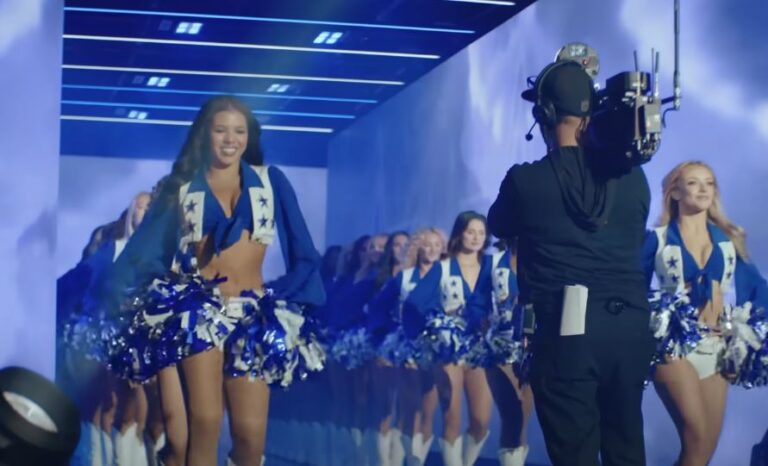A startlingly candid depiction of the Dallas Cowboys Cheerleaders emerged during the Netflix documentary series “America’s Sweethearts.” It went beyond sequins and choreography to focus on pay, side gigs, and the high expense of glamour. The fact that many cheerleaders made less money than mascots and waterboys astounded the audience. What was even more remarkable, though, was that despite being poised, athletic, and professionally trained, these women still required several jobs to make ends meet.
The squad’s prior pay structure felt antiquated and unworkable in the context of performance careers. The majority of cheerleaders received hourly pay of $15 to $20 and about $500 per game until recently. Due to their classification as independent contractors, they had much less access to fundamental worker protections like overtime, sick leave, and health insurance. When compared to the average NFL player, who makes $860,000 a year, or even NFL mascots, who are said to make about $25,000, their financial constraints were particularly obvious.
Dallas Cowboys Cheerleaders Compensation Table
| Category | Information |
|---|---|
| Team Name | Dallas Cowboys Cheerleaders |
| Year Founded | 1972 |
| Team Size | 36 members |
| Previous Annual Pay | Approximately $75,000 |
| Old Hourly Rate | $15 to $20 per hour |
| Game Fee Before Raise | $400–$500 per game |
| Current Raise | 400% increase |
| Estimated New Hourly Rate | $75 per hour (unofficial, based on media interviews) |
| Estimated New Annual Pay | Over $150,000 (varies with appearance and seniority) |
| Other Benefits | Appearance fees, beauty perks, promotional earnings, brand partnerships |
| Employment Type | Previously independent contractors, now shifting to better structured terms |
Through the docuseries, the cheerleaders strategically and subtly pushed the conversation into the public sphere by amplifying their voices. Their appeal was about dignity, not just pay. Week after week, cheerleaders like Amanda Howard and Jada McLean led a silent but concentrated movement in addition to their intense routines. By disclosing how their otherwise esteemed positions were plagued by financial instability, they provided emotional clarity to the problem.
The team’s internal cohesion and well-coordinated efforts forced the Cowboys’ management to reconsider its pay practices. What they were requesting was livable wages, not luxury. The outcome? The cheerleaders’ base pay has increased 400%, putting them in a position to make about $75 per hour. The package also includes improved appearance fees and performance incentives.
Former squad members have started discussing the financial evolution in public in recent days. In an Instagram post, Kristin Westbrook, who played for the team from 2019 to 2022, described the compensation plan. She explained that in the past, rookies in their first year made $100 per appearance, while veterans received raises based on their length of service. Even with the addition of these flat fees and game-day stipends, many people were still finding it difficult to keep up with the cost of living in places like Dallas.
By addressing historical inequalities, the group was able to establish an exceptionally successful precedent. This change benefits future performers from other NFL teams as well as the current cheerleaders. In an industry where many entertainment jobs are still viewed as side gigs rather than respectable careers, the DCC’s pay adjustment is especially creative.
The team’s longtime director, Kelli Finglass, openly called the pay increase “60-plus years long overdue.” Even though it is a stark admission, it illustrates how leadership circles are changing. Finglass and head choreographer Judy Trammell agreed that the cheerleaders’ tenacity was ultimately a crucial driver of change, despite the fact that it initially caused discomfort for management. The organization avoided public backlash and repositioned itself as a progressive establishment by incorporating feedback and maintaining flexibility.
“America’s Sweethearts” did more than just provide entertainment; it elevated cheerleader equity through clever storytelling and intimate interviews. Viewers found the series’ emotional throughline compelling because it gave the conversation names and faces. Armani Latimer, for example, spoke movingly about how she felt empowered to take part in the pay discussions, not only for herself but also for the future generations of women who would wear those recognizable white boots.
The Dallas Cowboys Cheerleaders accomplished something that has proven especially challenging in pink-collar industries by utilizing advocacy and the media in concert to alter their economic reality. Surprisingly, they accomplished this without the use of a formal union, instead relying on a public narrative that gave management limited options for termination. The bravery of the cheerleaders conveyed a remarkably similar message to the entertainment industry at large: that fair compensation is not incompatible with glamor.
The DCC’s accomplishment serves as a model for other NFL cheerleading squads. There are already rumors that other franchises are considering internal reviews and pay reassessments. This could drastically change expectations for performers in their early careers, allowing them to follow their passions without sacrificing their financial security.
The issue of pay equity has gained popularity recently in the fitness, fashion, and media industries. Now, the DCC’s story serves as a beacon, especially helpful for underappreciated actors, dancers, and broadcasters who are also looking for respect and recognition.
The effects of this raise on the team as a whole will probably go beyond salary increases. Higher pay results in improved performance, decreased burnout, and increased job satisfaction. These women now enter the field as advocates who have transformed their profession in addition to being entertainers.
